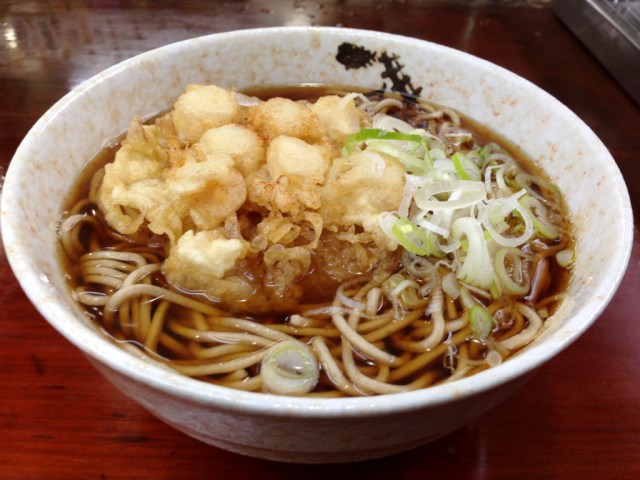
Our resident soba connoisseur hones in on the best eateries in the Akihabara and Okachimachi neighborhoods of Tokyo in this closely contested ranking.
Stand-and-eat (“tachigui”) soba shops are a dime a dozen in Tokyo, and are generally good for when you want to down a bowl of piping hot noodle soup in a limited time. Even so, not all stand-and-eat shops are made the same–some have pitfalls like disappointing broths or flattened noodles.
Seiji Nakazawa is our resident stand-and-eat soba restaurant expert. He’s eaten at 251 unique shops at this point and takes detailed notes to create various rankings of them for his colleagues and friends. Today he would like to introduce his most consistent go-tos for the five best stand-and-eat soba shops in the Akihabara-Okachimachi neighborhoods of Tokyo (which are also two stops directly next to each other on the Yamanote Line loop). They’re good places to keep in mind the next time you visit Akihabara’s de facto otaku shrine and need to grab a bite!
5. Kameya (Okachimachi branch)
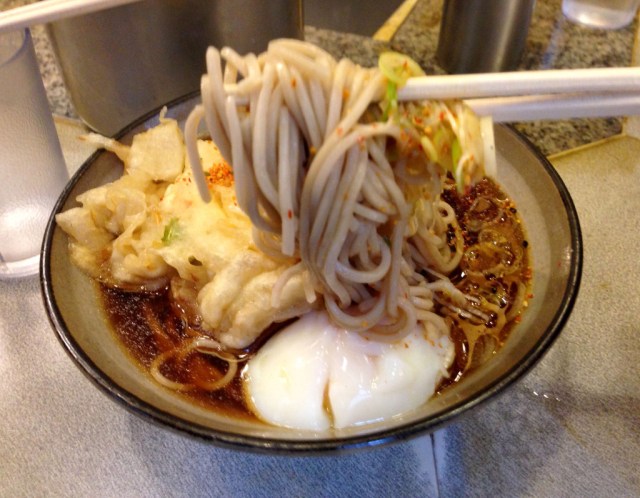
When a friend from outside Tokyo comes to visit and asks if there’s any good stand-and-eat soba restaurants around, Seiji recommends Kameya. It’s a solid all-around place to eat for both soba newbies and pros alike.
The soup there is mildly sweet with a depth of flavor. It completely permeates the large chunks of tempura adorning each bowl so that they instantly melt in your mouth. The same goes for the creamy egg yolks. Seiji recommends the tentama soba (450 yen/US$4.27) which includes both of these toppings. If you go to the Okachimachi branch at night, you can also experience the charming ambience amid soft lighting and a rustic setting.
Restaurant information
Kameya (Okachimachi branch) / かめや (御徒町店)
Address: Tokyo-to, Shinjuku-ku, Nishi-Shinjuku 1-2-10
東京都新宿区西新宿 1-2-10
Open: Monday-Friday 24 hours, Saturday 12 a.m.- 3 a.m. (Sunday morning)
Closed: Sunday
4. Futaba

Mixed vegetable and seafood tempura, chrysanthemum leaf tempura, squid tentacle tempura, squid tempura…there’s no end to the types of tempura you can order here! Japanese whiting, horse mackerel, carrot tempura, and littleneck clam mixed tempura are a few of the more unusual offerings.
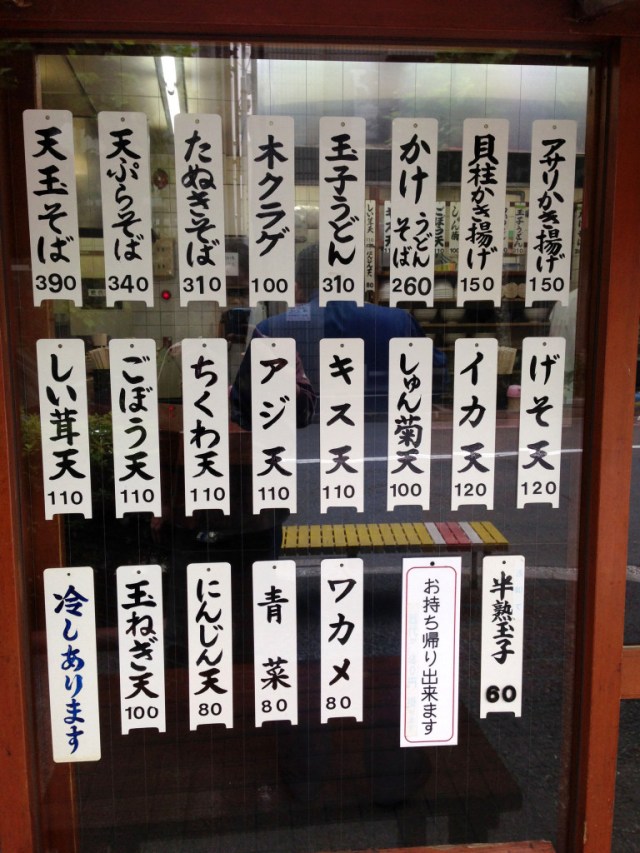
All types of tempura also have a great compatibility with the sweet broth. Seiji remarks that the noodles themselves are nothing special, but with the mixed vegetable and seafood tempura soba costing only 370 yen and the chrysanthemum tempura soba costing 390 yen, you can’t beat these prices for the toppings.
Restaurant information
Futaba / 二葉
Address: Tokyo-to, Chiyoda-ku, Kanda Izumi-cho 1-4-6 Nishigawa Building 1st floor
東京都千代田区神田和泉町 1-4-6 西川ビル 1F
Open: Monday-Friday 7:30 a.m.-5 p.m.
Closed: Saturday, Sunday
3. Chicken Stock Soba and Udon Sanchome
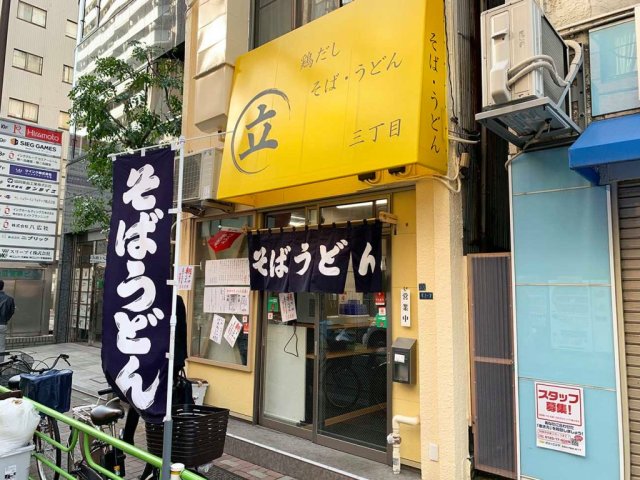
Speaking of affordability, Sanchome wins the prize. It’s nestled right in front of Naka-Okachimachi Station on the Tokyo Metro Hibiya Line, making it perfect for a quick bite while commuting back and forth. Seiji says to take note of the morning soba served between 7-10 a.m. for an incredibly cheap 300 yen.
It’s also unusual to find a stand-and-eat soba restaurant that uses a chicken-based broth. The depth of flavor it lends is particularly warming on a cold winter morning, and the noodles are firm and perfectly passable for the price. A chicken tempura topping guarantees that you can indulge in all manner of chicken-flavored bites to your heart’s content. Other than that the seafood and vegetable specials change daily, meaning you’ll never get tired of the balance of flavors.
Restaurant information
Chicken Stock Soba and Udon Sanchome / 鶏だしそば・うどん 三丁目
Address: Tokyo-to, Taito-ku, Taito 3-42-7
東京都台東区台東 3-42-7
Open: Monday-Friday 7 a.m.- 2 p.m.
Closed: Saturday, Sunday
2. Minogasa
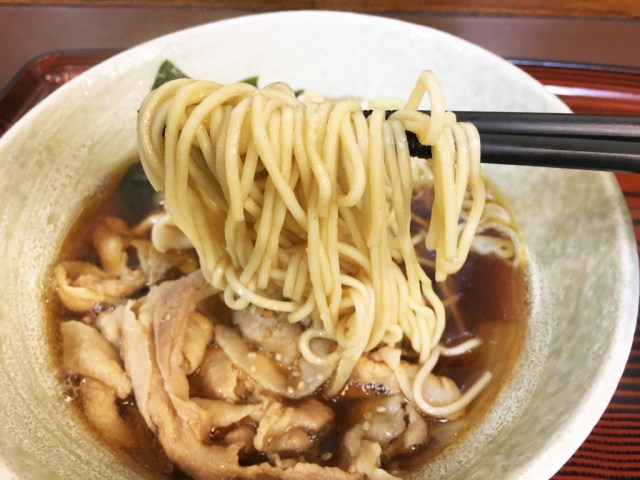
Minogasa actually maintains three branches in the Akihabara and Okachimachi neighborhoods. Its slender noodles are outstanding representatives of the soba variety. In fact, they’re made using a premium buckwheat flour cultivated in Togakushi, Nagano Prefecture–one of the country’s most noteworthy places for soba.
Despite its one-of-a-kind soba dishes, Minogasa also serves delicious curries and tempura rice bowls, which is one reason why Seiji can’t stop going back. The rice bowls in particular each have their own flair depending on the location. Seiji personally loves the yakiniku rice bowl found at the Kuramaebashi-dori branch and urges you to try it as well.
Restaurant information
Minogasa (main branch) / みのがさ (本店)
Address: Tokyo-to, Chiyoda-ku, Iwamoto-cho 3-10-5
東京都千代田区岩本町 3-10-5
Open: Monday-Friday 11:30 a.m.- 2 p.m., 5:30-11:30 p.m. (alcoholic beverages also available)
Closed: Saturday, Sunday
1. Kawaichi

Kawaichi earns the top spot for Seiji’s stand-and-eat soba recommendation in the jostling crowds of Akihabara. Its “holy trinity” of extremely rich soup, pleasantly firm soba, and toppings with no shortage of good umami flavor earn it the highest marks for all-around quality.
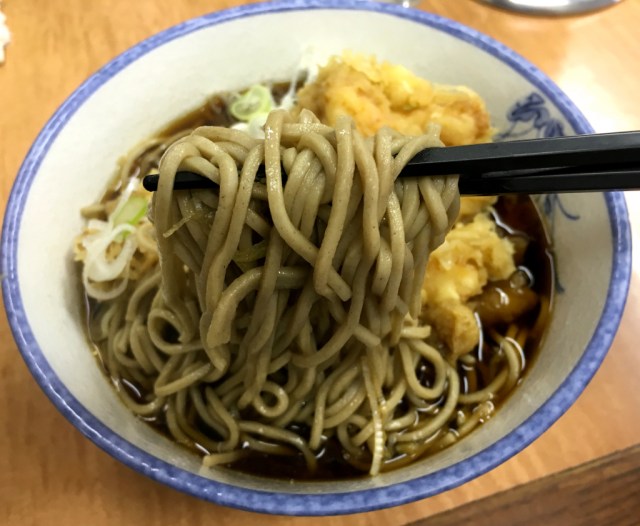
Kawaichi also has a great cost-to-value ratio and can be likened to a full-fledged sit-down soba restaurant. Its only potential downside is that it isn’t open on the weekend, but that’s not all that uncommon as you’ll see just from this list.
Restaurant information
Kawaichi / 川一
Address: Tokyo-to, Taito-ku, Taito 1-2-7
東京都台東区台東 1−2−7
Open: Monday-Friday 7 a.m.- 9 p.m.
Closed: Saturday, Sunday
If you find yourself in the area and aren’t quite feeling the soba vibe, maybe a shaken ramen in a bubble tea cup will do the trick instead.
All images © SoraNews24
● Want to hear about SoraNews24’s latest articles as soon as they’re published? Follow us on Facebook and Twitter!

No hay comentarios:
Publicar un comentario